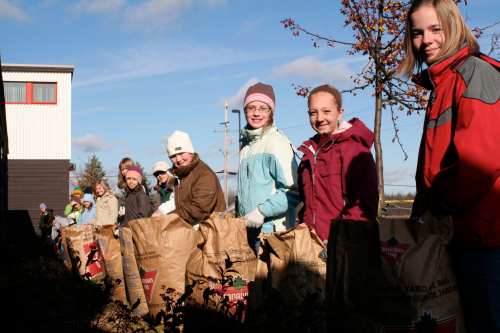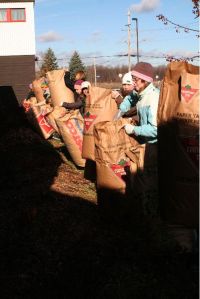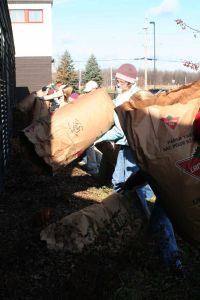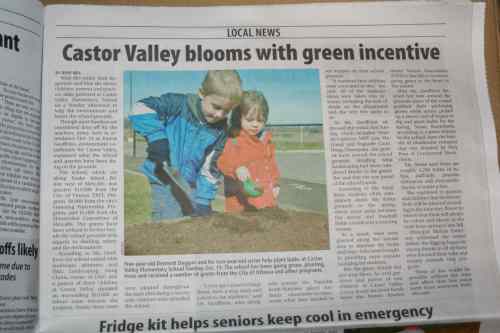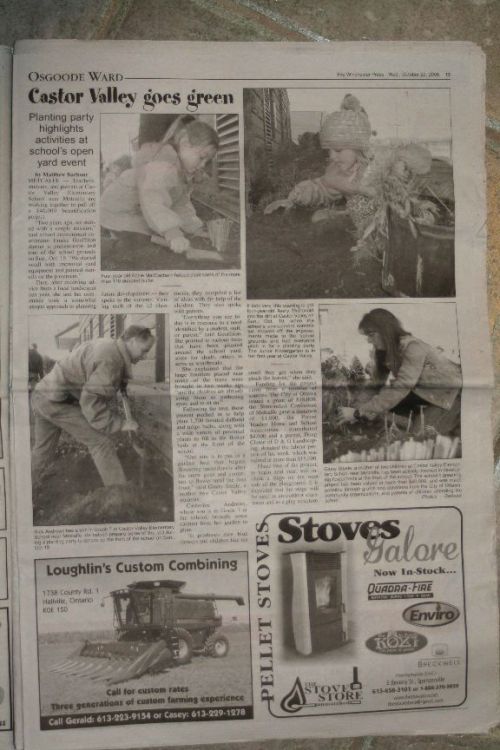In Autumn 2007 I put some work into the flowerbed at the front entrance of the elementary school my kids attend, south of Ottawa.
I’d watched the bed for a year, waiting for something good to happen. I didn’t see anything I found exciting, so I offered to give it my flower-intense planting treatment. The school was very keen. PTA gave about $38 funds to cover daffodils and tulips I’d bought for them. I divided my own perennials from my garden to put in at the front of the school. The idea: to have a constant flower show at the front.
Well, it worked. But here’s the thing – I never got round to taking any photos! There was a point when flowers were thin there, but a couple of new species planted in the mix will fix that.
Now we’re in Autumn/Fall 2008 (Autumn to me, I’m English), and the school has put in 43 new trees, courtesy of various local grants. I had gone into school in mid-September to meet the Environment Coordinator, really just to tell her I’d do the same flower-intense treatment for a set of 3 raised square planter boxes they’ve got there. When I was talking to her, it struck me as a great idea to build a bed along the front of the school. Currently there were a set of ropy old Spireas there.
 This is the site I suggested for a continuously flowering bed. It’s full east facing, so gets morning sun, and the sun hours for spring/summer are enough to get full sun plants flowering.
This is the site I suggested for a continuously flowering bed. It’s full east facing, so gets morning sun, and the sun hours for spring/summer are enough to get full sun plants flowering.
There were a lot of steps involved to make a bed happen there:
• scrape the sod
• turn the bed
• incorporate soil amendments (mushroom compost)
• acquire perennials and spring flowering bulbs to carry the flowering show from earliest spring through to hard frost in fall
• plant all the donations
• mulch with shredded leaves
The Principal of the school approved the idea and I approached some local companies for donations of spring flowering bulbs.
I met with great success. Home Depot in Barrhaven, 
and on Bank Street near South Keys gave me bulbs. Barrhaven gave me a LOT of bulbs! Moncion’s Independent Grocers gave me a lot of bulbs too – mostly tulips. Peter Knippel on Bank Street gave me a collection of perennials by groups of 3, and Loblaws at Barrhaven came through with more bulbs. I collected just over 1500 bulbs from all these generous donors!
I sent out a newsletter, after PTA approval, letting parents know what we were trying to do and requesting their help.
Some very kind and committed parents emailed me with their intended donations – we had a couple of people kindly give us some fabulous peonies – even some divisions of wonderful heritage peonies brought by parent and horticulturist Catherine Andrews – and lots of plants from my list of species of drought tolerant plants were given. We got other species too – lots of stuff to make an interesting bed which has a constantly changing flower show.
The landscaping contractor who installed the trees made a personal donation of labour to scrape the sod off the new bed location. The bed was to measure 3ft deep by the entire available length which I estimate to be 70ft.
I went to the school to work on the box beds, but decided I’d better just take a look at the new bed, for its soil quality. Well, the moment I dug my shovel in, I realised how tough it was going to be; the soil was heavy clay based, with crushed stone dust from building construction mixed in. No wonder nothing wanted to grow there. I dug and turned that bed till I was nearly giddy, and only did half of it. I was in bed that night – exhausted – at 7.40pm! The next day, my fantastic friend Bridget Evoy came and gave me a hand and together we turned most of it, and dug a proper division channel between soil and sod, to reduce the chance of grass roots walking into the new bed.
I told the Environment Coordinator that we’d need some good soil amendments. Nick Pora of Continental Mushroom offered us some of his mushroom compost, which was fabulous. He delivered on Friday 17 October. Another parent, Gilles Mercier, brought along his tractor and moved 4 cubic yards of mushroom compost into finished location on the bed on the morning of 19 October. This was a massive help as it would have taken a team of us all day with barrows.
 I had invited the school community to come to this ‘Planting Party’, and it turned out well. The weather was fabulous – 12ºC, no wind. My friend Bridget brought some music and a boombox to help things along. Some other people brought drinks and I brought chocolate chip cookies. It was great to see people come out to help. Weekends are precious to all – nobody has enough time these days, so giving part of it up for this was wonderful. My son’s JK teacher, Ms Shankar came with her family too! It was fabulous to see people reaching out to get involved and I am very happy with the effort we all made that day.
I had invited the school community to come to this ‘Planting Party’, and it turned out well. The weather was fabulous – 12ºC, no wind. My friend Bridget brought some music and a boombox to help things along. Some other people brought drinks and I brought chocolate chip cookies. It was great to see people come out to help. Weekends are precious to all – nobody has enough time these days, so giving part of it up for this was wonderful. My son’s JK teacher, Ms Shankar came with her family too! It was fabulous to see people reaching out to get involved and I am very happy with the effort we all made that day.
 Planting began at 1.00pm on Sunday 19 October.
Planting began at 1.00pm on Sunday 19 October.
The last of us packed up and left at 5.00 today. Tired, bed filled. Nearly all the bulbs planted. I got in all the donated bulbs I’d collected, but I couldn’t find space in that bed for all the 200 extra daffodils that Catherine Andrews kindly brought along. Can you imagine so many bulbs you can’t actually fit them all in? That’s a lot of bulbs! The rest had to go into a big raised bed behind the school secretaries’ area.
Nice problem to have, too many bulbs!
A huge thank you to everybody who donated for that bed, helped make it and plant it. Today we made a difference to the school environment. In 2009 and every year afterwards this school will have lots of flowers for the children to enjoy.
 I look forward to including photos in 2009 of this bed and the 3 box planters, full of flowers as they start to bloom. But most of all, I hope to overhear the squeals of delight from the little children as they spot the first crocuses in joyful bloom after the long Canadian winter.
I look forward to including photos in 2009 of this bed and the 3 box planters, full of flowers as they start to bloom. But most of all, I hope to overhear the squeals of delight from the little children as they spot the first crocuses in joyful bloom after the long Canadian winter.
Ginny Steele
